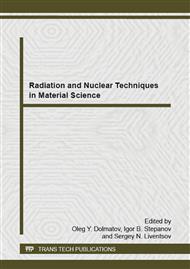[1]
N.V. Gagarina, V.E. Sinitsin, T.N. Veselova, S.K. Ternovoi, Modern methods of diagnosis of pulmonary embolism, Kardiologiya(in Russian). 5 (2003) 77-81.
Google Scholar
[2]
Guidelines on the diagnosis and management of acute pulmonary embolism, Eur. Heart J. 29 (2008) 3066-3067.
Google Scholar
[3]
V.S. Savel'eva, Phlebology, Meditsina, Moscow, (2001).
Google Scholar
[4]
A. Ribeiro, P. Lindmarker, H. Johnsson, A. Juhlin-Dannfelt, L. Jorfeldt, Pulmonary embolism. One-year follow-up with echocardiography doppler and five-year survival analysis, J. Circulation. 99 (1999) 1325-1330.
DOI: 10.1161/01.cir.99.10.1325
Google Scholar
[5]
P.O. Daily, W.R. Auger, Historical perspectives: Surgery for chronic thrombormbolic disease. Semin. Thorac. Cardivasc. Surg. 11 (1999) 143-151.
Google Scholar
[6]
R. W van der Meer, P.M. Pattynama, M.J. van Strijen, A.A. van den Berg-Huijsmans, I.J. Hartmann, H. Putter, A. de Roos, M.V. Huisman, Right ventricular dysfunction and pulmonary obstruction index at helical CT: prediction of clinical outcome during 3-month follow-up in Patients with acute pulmonary embolism, J. Radiology. Cardiac Imaging. 235, 3 (2005).
DOI: 10.1148/radiol.2353040593
Google Scholar
[7]
A. Kjr, A.M. Lebech, B. Hesse, C.L. Petersen, Right-sided cardiac function in healthy volunteers measured by first-pass radionuclide ventriculography and gated blood pool SPECT: comparison with cine MRI. J. Clin. Physiol. Funct. Imaging, 25 (2005).
DOI: 10.1111/j.1475-097x.2005.00635.x
Google Scholar
[8]
E.K. Ueir, G.T. Rivs, Physiology and pathophysiology of pulmonary vessels, Meditsina, Moscow, 1995 (in Russian).
Google Scholar
[9]
E.N. Ostroumov, D.V. Shumakov, I.A. Mochkin, The implementation of the fundamental principles of interventricular interaction in the prognostication of intraoperative necessity of the mechanical circulatory support in patients with ischemic heart disease, Kardiologiya, 10 (2001).
Google Scholar
[10]
K.M. Moser, M. Stein, Pulmonary Thromboembolism Year Book Medical Publishers, Michigan, (1973).
Google Scholar
[11]
J. Endrys, N. Hayat, G. Cherian, Comparison of bronchopulmonary collaterals and collateral blood flow in patients with chronic thromboembolic and primary pulmonary hypertension. J. Heart, 78, 2 (1997) 171-176.
DOI: 10.1136/hrt.78.2.171
Google Scholar
[12]
P. Bresser, P.F. Fedullo, W.R. Auger, R.N. Channick, et al., Continuous intravenous epoprostenol for chronic thromboembolic pulmonary hypertension, Eur. Respir. J., 23, 4 (2004) 595-600.
DOI: 10.1183/09031936.04.00020004
Google Scholar
[13]
D. Chemla1, V. Castelain1, P. Hervé, Y. Lecarpentier, S. Brimioulle, Haemodynamic evaluation of pulmonary hypertension, Eur. Respir. J., 20 (2002) 1314-1331.
Google Scholar
[14]
S.I. Said, Mediators and modulators of pulmonary arterial hypertension, Am. J. Physiol. Lung Cell Mol. Physiol. 291, 4 (2006) 547-558.
Google Scholar
[15]
W.R. Auger, R.N. Channick, K.M. Kerr, P.F. Fedullo, Evaluation of patients with suspected chronic thromboembolic pulmonary hypertension, Semin. Thorac. Cardiovasc. Surg. 11, 2 (1999) 179-190.
DOI: 10.1016/s1043-0679(99)70011-0
Google Scholar
[16]
P. Dartevelle, E. Fadel, S. Mussot, A. Chapelier, P. Hervé, M. de Perrot, J. Cerrina, F.L. Ladurie, D. Lehouerou, M. Humbert, O. Sitbon, G. Simonneau, Chronic thromboembolic pulmonary hypertension, Eur. Respir. J., 23 (2004) 637-648.
DOI: 10.1183/09031936.04.00079704
Google Scholar
[17]
P.F. Fedullo, W.R. Auger, K.M. Kerr, L.J. Rubin, Chronic thromboembolic pulmonary hypertension, New Engl. J. Med. 345 (2001) 1465-1472.
DOI: 10.1056/nejmra010902
Google Scholar
[18]
C. Claussen, S. Miller, M. Fenchel, U. Kramer, R. Reissen, Cardiac Imaging ISBN 160406014X, 9781604060140 Thieme, (2007).
Google Scholar
[19]
T. Kunieda, N. Nakanishi, T. Satoh, S. Kyotani, Y. Okano, N. Nagaya, Prognoses of primary pulmonary hypertension and chronic major vessel thromboembolic pulmonary hypertension determined from cumulative survival curves, J. Int. Med. 38 (1999).
DOI: 10.2169/internalmedicine.38.543
Google Scholar


